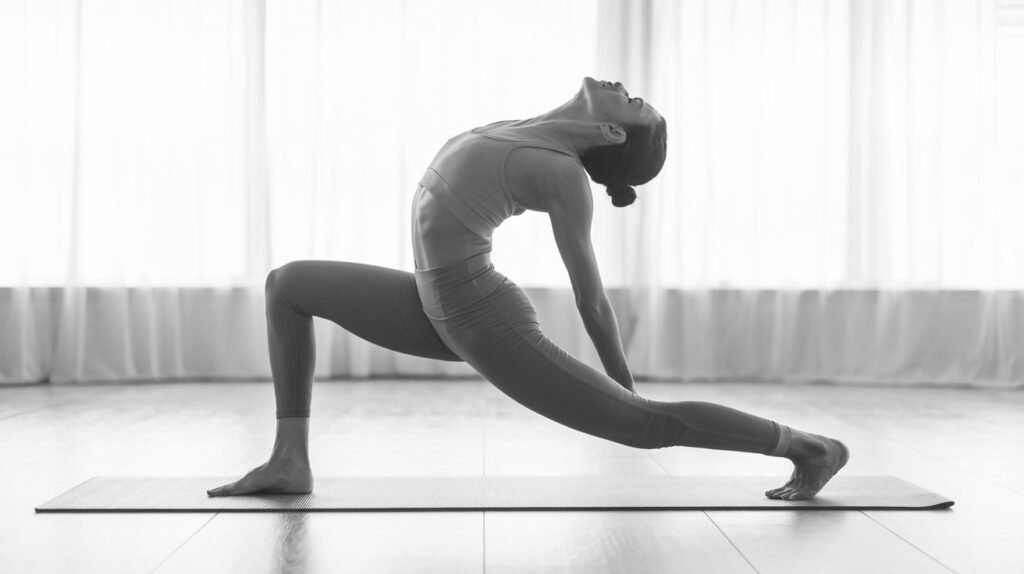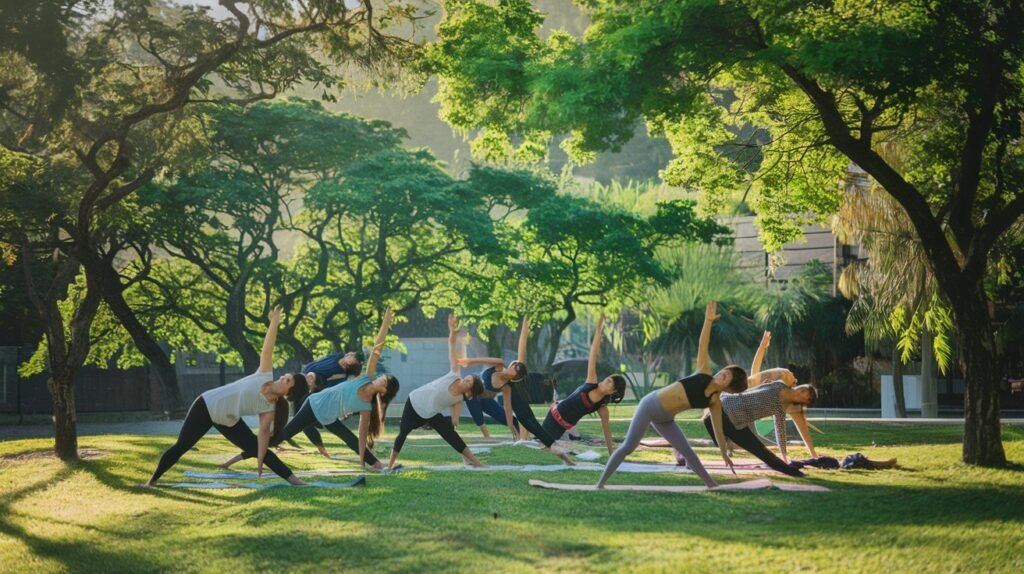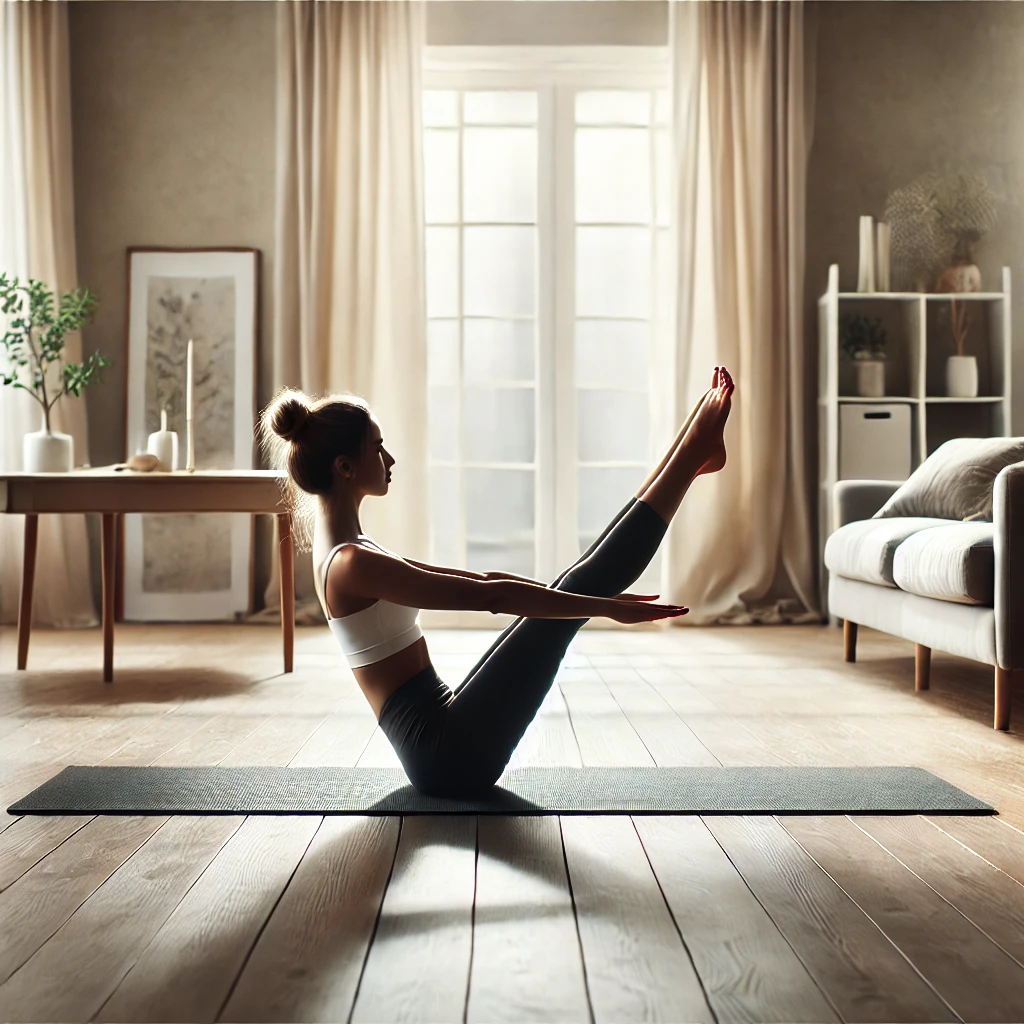Core strength has become a central focus for many people. From athletes and fitness enthusiasts to those looking to improve posture and reduce back pain, core strength plays a vital role in overall health. One of the most effective and holistic ways to build core strength is through yoga. Unlike traditional exercises that isolate specific muscles, yoga engages your entire body while also working deeply on your core, improving not only strength but also flexibility, balance, and stability.
We’ll explore how yoga for core strength can help you build a solid foundation, the best yoga poses for core activation, and how to integrate these poses into your routine for optimal results. Additionally, we’ll discuss the science behind core-focused yoga and provide tables and statistics to illustrate its effectiveness.
Table of Contents
What is Core Strength and Why is it Important?
Core strength refers to the ability of the muscles in your abdominal region, lower back, hips, and pelvis to support your body’s movements and maintain stability. A strong core is essential for nearly every movement we make, whether it’s lifting objects, sitting with good posture, or performing athletic activities. Core muscles include the rectus abdominis, obliques, transverse abdominis, and muscles of the pelvic floor and lower back.

Why is Core Strength Important?
- Improves Posture: A strong core helps you sit and stand with better posture, reducing strain on your spine.
- Enhances Balance and Stability: Core muscles provide support for your entire body, enhancing stability and reducing the risk of falls or injuries.
- Prevents Back Pain: Strengthening your core takes pressure off your lower back, reducing the likelihood of back pain or injuries.
- Supports Overall Fitness: A strong core improves your performance in other physical activities such as running, weightlifting, and even daily tasks.
Yoga for Core Strength: How It Helps Develop Core Strength
Unlike many traditional workouts that focus on isolated movements like crunches or planks, yoga works on core strength holistically. In yoga, core muscles are engaged in nearly every pose, promoting functional strength that helps in real-world activities. Here’s how yoga helps with core strength:
a. Functional Movement
Yoga focuses on moving the body in ways that require the engagement of multiple muscle groups. Core muscles, especially the deep core muscles, are continuously activated to maintain balance and stability in various poses.
b. Dynamic Stretching
Many yoga poses involve dynamic movements, such as transitioning from Downward Dog to Plank Pose, which engage core muscles in a variety of ways, enhancing strength and endurance.
c. Breath and Core Activation
Yoga emphasizes the connection between breath and movement. In poses that engage the core, such as Boat Pose or Chair Pose, synchronized breathing helps to activate and strengthen the core muscles.
| Core Activation in Yoga | Benefit |
|---|---|
| Dynamic movements (Plank to Downward Dog) | Increases core stability |
| Balance poses (Tree Pose, Warrior III) | Enhances core endurance |
| Twists (Seated Twist, Revolved Triangle) | Strengthens obliques and deep core muscles |
d. Mind-Body Awareness
Yoga encourages mindfulness, which allows you to focus on the specific engagement of your core muscles during each pose. This helps improve body alignment, muscle activation, and overall strength.
Yoga for Core Strength: Best Poses

There are certain poses of Yoga For Core Strength. These poses target different parts of the core, including the abdominal muscles, obliques, and lower back. Below are some of the best yoga poses to strengthen your core.
| Pose | Targeted Muscles | Difficulty Level |
|---|---|---|
| Plank Pose | Rectus abdominis, transverse abdominis, shoulders | Moderate |
| Boat Pose | Lower abs, hip flexors, obliques | Challenging |
| Side Plank | Obliques, shoulders, transverse abdominis | Challenging |
| Chair Pose | Rectus abdominis, lower back, legs | Moderate |
| Warrior III | Lower back, glutes, abs | Moderate |
| Bridge Pose | Lower back, glutes, abs | Easy |
| Revolved Triangle Pose | Obliques, transverse abdominis | Moderate |
Plank Pose (Phalakasana)
Plank Pose is one of the most effective poses of yoga for core strength. It engages the entire core, including the rectus abdominis and the transverse abdominis. To perform this pose:
- Start in a tabletop position, with your shoulders over your wrists and your knees under your hips.
- Step your feet back and straighten your legs, forming a straight line from your head to your heels.
- Keep your core engaged and hold the position for 30 seconds to 1 minute.
Boat Pose (Navasana)
Boat Pose strengthens the lower abs and obliques while improving balance. Here’s how to do it:
- Sit on the mat with your knees bent and feet flat on the floor.
- Lean back slightly and lift your feet off the ground, balancing on your sit bones.
- Extend your legs if possible and raise your arms parallel to the floor. Keep your core engaged.
- Hold for 20-30 seconds.
Here are additional paragraphs describing other effective yoga poses for core strength to complete the section:
Side Plank Pose (Vasisthasana)
Side Plank Pose is an excellent way to target the obliques and build overall core stability. This pose requires balance and strength, as it challenges your ability to maintain a strong line from your head to your feet while engaging the lateral muscles of the abdomen. To perform Side Plank Pose:
- Begin in a Plank Pose.
- Shift your weight onto your right hand and rotate your body to the side, stacking your left foot on top of your right.
- Extend your left arm towards the ceiling, opening your chest and hips.
- Hold the position for 15-30 seconds, then switch sides.
In addition to working the obliques, Side Plank also engages the shoulders and improves balance, making it a well-rounded pose for core strength.
Chair Pose (Utkatasana)
Chair Pose is a foundational pose that helps build strength in the rectus abdominis, lower back, and legs. It mimics the action of sitting in an imaginary chair, which activates the core and encourages stability. To practice Chair Pose:
- Stand with your feet together and arms at your sides.
- Inhale and raise your arms overhead, keeping your biceps close to your ears.
- Exhale as you bend your knees and lower your hips, as if sitting back into a chair.
- Keep your weight in your heels and your chest lifted. Hold the pose for 30 seconds to 1 minute, breathing steadily.
Chair Pose not only strengthens the core but also engages the thighs and helps improve posture.
Warrior III (Virabhadrasana III)
Warrior III is a powerful balancing pose that targets the lower back, glutes, and abdominal muscles. This pose requires concentration and stability, making it a great way to enhance core strength. To perform Warrior III:
- Begin in a standing position. Shift your weight onto your left foot and lift your right leg behind you, keeping it straight.
- Lean your torso forward, bringing your arms forward or alongside your body, creating a straight line from your fingertips to your lifted heel.
- Engage your core to maintain balance and hold for 15-30 seconds before switching sides.
Warrior III not only strengthens the core but also improves balance and coordination, making it a valuable addition to any yoga practice.
Bridge Pose (Setu Bandhasana)
Bridge Pose is a gentle yet effective way to strengthen the lower back, glutes, and abdominal muscles. It helps open the chest and hips while providing a stretch to the spine. To practice Bridge Pose:
- Lie on your back with your knees bent and feet hip-width apart, flat on the floor.
- Press your feet into the ground and lift your hips towards the ceiling, engaging your core and glutes.
- You can clasp your hands under your back or keep your arms at your sides for support.
- Hold the pose for 30 seconds to 1 minute, breathing deeply.
Bridge Pose is particularly beneficial for counteracting the effects of prolonged sitting, making it a perfect addition to a core-strengthening routine.
Revolved Triangle Pose (Parivrtta Trikonasana)
Revolved Triangle Pose is a dynamic pose that challenges your core stability while also stretching the hamstrings and strengthening the obliques. To perform this pose:
- Begin in a standing position and step your feet wide apart.
- Turn your right foot out and your left foot slightly in. Reach forward with your right hand to touch your right ankle or floor.
- Rotate your torso to the left, extending your left arm towards the ceiling.
- Keep your core engaged and hold for 15-30 seconds before switching sides.
Revolved Triangle Pose enhances balance and flexibility while actively engaging the core, making it an essential pose for core strength development.
How to start a Yoga for Core Strength
Creating a routine of yoga for core strength can help you achieve your fitness goals. Here’s how you can structure your practice:
a. Warm-Up (5-10 minutes)
Start with gentle stretching and breathing exercises to prepare your body for core engagement. Cat-Cow Pose and Child’s Pose are great warm-up options.
b. Core-Engaging Poses (20-25 minutes)
Incorporate core-focused poses such as Plank Pose, Boat Pose, and Side Plank. Hold each pose for 30-60 seconds, and repeat for 3-5 rounds.
c. Balance Poses (10-15 minutes)
Practice poses that challenge your balance and further engage your core, such as Warrior III, Half Moon Pose, and Tree Pose.
d. Cool Down (5-10 minutes)
Finish with stretches that relax the core muscles and promote recovery. Seated Forward Fold and Supine Twist are excellent options.
| Routine Component | Duration |
|---|---|
| Warm-up | 5-10 minutes |
| Core-engaging poses | 20-25 minutes |
| Balance poses | 10-15 minutes |
| Cool down | 5-10 minutes |
Yoga for Core Strength: The Benefits of Core Strength

While core strength is essential for fitness, its benefits extend far beyond athletic performance. Here’s how a strong core can improve your everyday life:
a. Improved Posture
A strong core supports better posture, reducing strain on your neck, shoulders, and lower back.
b. Enhanced Mobility
A strong core allows for greater range of motion and flexibility, reducing the risk of injuries in daily activities.
c. Reduced Risk of Injury
Strengthening your core muscles helps stabilize your body during movement, protecting your lower back and joints from injury.
d. Boosted Mental Focus
Yoga promotes mindfulness and concentration. As you build core strength, you also enhance your ability to focus and stay present in the moment.
Common Mistakes to Avoid in Yoga for Core Strength
When practicing yoga for core strength, there are a few common mistakes that can prevent you from achieving your goals or lead to injury:
- Overarching the Back in Plank Pose: Ensure your back remains in a neutral position, with your core engaged and hips aligned.
- Holding Your Breath: Breath control is essential in yoga. Focus on deep, steady breathing to engage your core effectively.
- Rushing Through Poses: Yoga is about mindful movement. Take your time transitioning between poses to ensure proper form and full engagement of your core muscles.
Real-Life Success Stories: Yoga for Core Strength
Many individuals have experienced life-changing results from practicing yoga for core strength. Here are two real-life stories:
- Megan’s Story: “After years of dealing with chronic back pain, I started doing yoga twice a week. I focused on core-strengthening poses like Boat Pose and Plank Pose. Within a few months, my back pain was significantly reduced, and my posture improved.”
- David’s Journey: “As an athlete, I wanted to improve my core strength for better performance. I incorporated Power Yoga into my routine and noticed a huge improvement in my balance and stability. My workouts have become more efficient thanks to a stronger core.”
Yoga for Core Strength: The Conclusion
Yoga for core strength is an effective and holistic approach to building a strong and stable core. By practicing core-engaging poses and incorporating mindfulness into your movements, you can develop functional strength that enhances not only your fitness but also your daily life. Whether you’re looking to improve posture, reduce back pain, or enhance athletic performance, Yoga for Core Strength offers a comprehensive solution.
References
- Schmid, A., & Vleeming, A. (2016). The role of the core in postural control and athletic performance: A comprehensive review. Journal of Sports Medicine and Physical Fitness, 56(4), 401-413.
- Sherman, K. J., Wellman, R. D., & Cook, A. J. (2013). Yoga for back pain: A review of research. Pain Medicine, 14(5), 756-766.
- Raub, J. A. (2002). Psychophysiologic effects of Hatha yoga on musculoskeletal and cardiopulmonary function: A literature review. The Journal of Complementary and Alternative Medicine, 8(6), 797-812.




